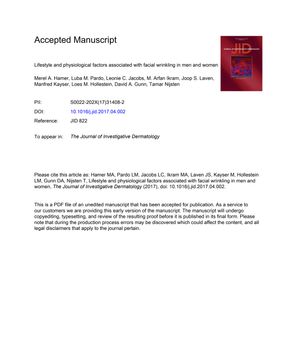TLDR Age, smoking, and lower BMI increase facial wrinkles; men wrinkle more than women, except in old age; pale skin and certain hormonal factors can protect against wrinkles.
The study examined the factors contributing to facial wrinkling in 3,831 north-western Europeans aged 51-98 years, finding that age was the strongest determinant, with smoking and lower BMI also significantly linked to increased wrinkling. Men generally had more wrinkles than women, except in the oldest age group. Protective factors against wrinkles included pale skin color and, in women, female pattern hair loss (FPHL) and a higher free androgen index (FAI). Lifestyle factors like education level and alcohol consumption in women, and a tendency to sunburn in men, were also associated with wrinkling. The study highlighted sex differences in skin aging and suggested that strategies to reduce skin aging should consider these differences. It also indicated that other factors, including genetics, might play a role in facial wrinkling, as the determinants explained 22% of the variability in men and 37.2% in women. The study was limited by its cross-sectional design and the homogeneity of the study population.
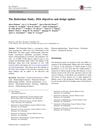 336 citations
,
August 2015 in “European Journal of Epidemiology”
336 citations
,
August 2015 in “European Journal of Epidemiology” The Rotterdam Study found risk factors for elderly diseases, links between lifestyle and genetics with health conditions, and aimed to explore new areas like DNA methylation and sensory input effects on brain function.
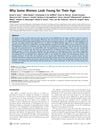 175 citations
,
November 2009 in “PLOS ONE”
175 citations
,
November 2009 in “PLOS ONE” Women look young for their age due to larger lips, less sun damage, and genes that prevent gray hair and wrinkles.
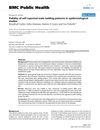 32 citations
,
December 2004 in “BMC Public Health”
32 citations
,
December 2004 in “BMC Public Health” Men can report their own balding patterns well enough for large health studies.
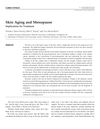 180 citations
,
January 2003 in “American Journal of Clinical Dermatology”
180 citations
,
January 2003 in “American Journal of Clinical Dermatology” Menopause can lead to skin and hair problems due to hormonal changes, but hormone replacement therapy might help slow these effects.
 666 citations
,
September 1977 in “British Journal of Dermatology”
666 citations
,
September 1977 in “British Journal of Dermatology” Common baldness, also known as Androgenetic Alopecia, is caused by a combination of genetic factors and hormones called androgens.
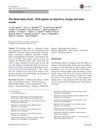 359 citations
,
September 2017 in “European Journal of Epidemiology”
359 citations
,
September 2017 in “European Journal of Epidemiology” The Rotterdam Study updated findings on elderly health, focusing on heart disease, genetics, lifestyle effects, and disease understanding.
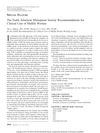 254 citations
,
September 2014 in “Menopause”
254 citations
,
September 2014 in “Menopause” The NAMS 2014 recommendations guide healthcare providers on treating health issues in midlife women, emphasizing individualized care and informed decision-making.
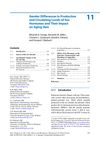 September 2014 in “Springer eBooks”
September 2014 in “Springer eBooks” Men and women experience skin aging differently due to changes in sex hormone levels with age.
 336 citations
,
August 2015 in “European Journal of Epidemiology”
336 citations
,
August 2015 in “European Journal of Epidemiology” The Rotterdam Study found risk factors for elderly diseases, links between lifestyle and genetics with health conditions, and aimed to explore new areas like DNA methylation and sensory input effects on brain function.
7 citations
,
January 2020 in “Skin Appendage Disorders” Take care of your hair as much as your face for a youthful look.
